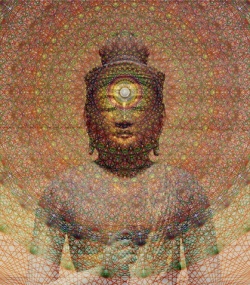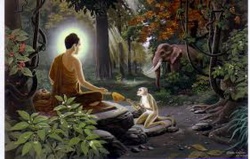Recycled Universe: Theory Could Solve Cosmic Mystery
By Ker Than
One of the biggest mysteries in cosmology could be explained by a controversial theory in which the universe explodes into existence not just once, but repeatedly in endless cycles of death and rebirth.
Called the cyclic universe theory, it could potentially explain why a mysterious repulsive form of energy known as the "cosmological constant" and which is accelerating the expansion of the universe is several orders of magnitude smaller than predicted by the standard Big Bang model.
In a new study detailed in the May 5 issue of the journal Science, Paul Steinhardt of Princeton University and Neil Turok of Cambridge University propose that the constant was once much larger, but that its value decayed with each incarnation of the universe.
Puzzling great minds
The cosmological constant, also known as "lambda", is thought to be a form of energy that gravitationally repels itself and causes the expansion of the universe to speed up.
Einstein initially proposed it as a counterforce to the gravitational attraction of matter to explain why the universe appeared static, neither growing nor shrinking. He later discarded the idea, however, when observations by astronomer Edwin Hubble revealed the universe was in fact expanding.
Lambda was revived in the late 1990s when astronomers discovered that the universe was not only expanding, but that it was doing so at an accelerated pace.
Scientists are still not sure what lambda is. According to one popular idea, it is the energy of space itself. According to quantum physics, the seemingly empty vacuum of space actually contains phantom particles that continually blink in and out of existence like flecks of sea foam. These particles are fleeting, but their energies combine to give every cubic centimeter of space a certain amount of energy. According to general relativity, this "vacuum energy" produces an anti-gravitational force that pushes spaceand the matter in itapart.
But there is a problem: the lambda that scientists have detected is more than a googol (1 followed by 100 zeros)times smaller than what theory predicts. To explain such a large discrepancy, physicists have been forced to come up with ever wilder theories.
Explaining lambda
One idea is that the lambda is not really small, but only seems so because it is being cancelled out by another unknown force with near perfect precision. To date, though, no mechanism has been found that can cause this cancellation.
An alternative solution is that of "anthropic selection," a controversial idea that attempts to explain why so many constants in nature appear to be precisely the right value to produce life. If lambda were too large, for example, the universe would have instantly blown up shortly after the Big Bang.
According to the so-called Anthropic Principle, certain features of the universe are selected by the requirement that observersin our case, humanscan detect them. In other words, only in a universe where lambda is small can intelligent beings exist who can wonder why it is small.
There are different ideas about how anthropic selection works. One possibility is that there are many parallel universes coexisting together; each would have constants of different values and in our universe, those constants can sustain life.
A similar idea is that there is only one infinite universe, but lambda varies from region to region. We just happen to live in a rare bubble where the constant is just right for galaxies and starsand usto form.
Anthropic selection makes many scientists uneasy because it suggests that the laws of physics might work differently in remote parts of the universe. In its strongest form, anthropic selection could also be viewed as support for creationism, since it suggests that the universe is somehow fine-tuned specifically for intelligent life.
"The anthropic idea suggests that, in order to explain the universe that we do see, we must make very strong assumptions about other universes we can never see," Steinhardt told SPACE.com. "Also, it assumes our universe is atypical. These assumptions are not normal in science and it's not clear that we must head in such a radical direction."
Cyclic universe
The idea of a cyclic universe, first proposed in 2002 by Steinhardt and Turok, is an alternative to anthropic selection.
"The [value of lambda] is one of the prime mysteries of physics," Steinhardt said. "It's really been so puzzling that it's driven the physics community to this anthropic approach. So it's important to know if a non-anthropic solution might exist."
The researchers' latest tweak to their model is to have the value of lambda decay over time with each passing cycle of the universe and even within a single cycle.
Scientists experimented with a varying lambda before within the context of the standard Big Bang model, but it didn't work because the time required for it to reach its current low value was far longer than the known age of the universe.
Combining a decaying lambda with a cyclic universe potentially solves this problem.
'Ingenious'
Although he expressed other concerns about the cyclic universe theory, Alexander Vilenkin, a cosmologist at Tufts University in Massachusetts who was not involved in the study, said Steinhardt and Turok's solution to the cosmological constant problem was "ingenious."
In a cyclic universe, new matter and energy are created about every trillion years when two sheet-like "branes" collide along an extra dimension of space. Branes are predicted by string theory.
Because there can be endless cycles, the universe would be far older than the 14.7 billion years that scientists currently estimate. This would allow ample time for lambda to shrink to what astronomers see now.
Steinhardt and Turok think lambda decreased in such a way that the rate of decay slowed with time. This means that observers measuring lambda are much more likely to get a small value than a large one.
Because a high lamda prevents the universe as we know it from forming, early cycles of the universe would have been void of galaxies, stars and life; only in later cycles, when lamda had decreased to a much smaller value, could matter coalesce to create the world we inhabit today.
The pair estimates that each cycle lasted about a trillion years. During this time, the universe runs its natural course, but all the while matter and energy fans out through space until they are extremely dilute.
"They are so dilute, in fact, that we would likely see not even a single particle of that early matter and radiation within our horizonthat is, the patch of space we can see," Steinhardt said.
Once the universe is emptied out, a weak attractive force brings our universe's two branes together in a cosmic collision. Each collision is essentially a new Big Bang that infuses the aging universe with new matter and energy.
Steinhardt says their crazy theory can be tested: the inflationary Big Bang theory predicts that gravitational waves produced at the end of inflation leave an imprint on the cosmic microwave background, a diffuse form of electromagnetic radiation that fills the universe.
If future experiments show the polarization pattern produced by such waves, it would disprove the cyclic universe theory, ruling it out as a possible solution to the cosmological constant problem. It is interesting that the Buddhas explanation of the origin of the universe corresponds very closely to the scientific view.
In the Aganna Sutta, the Buddha described the universe being destroyed and then re-evolving into its present form over a period of countless millions of years. The first life formed on the surface of the water and again, over countless millions of years, evolved from simple into complex organisms. All these processes are without beginning or end, and are set in motion by natural causes




